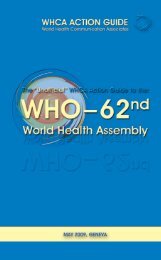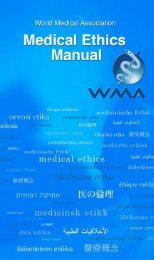the basics - World Health Communication Associates
the basics - World Health Communication Associates
the basics - World Health Communication Associates
- No tags were found...
Create successful ePaper yourself
Turn your PDF publications into a flip-book with our unique Google optimized e-Paper software.
TABLE 2. TECHNIQUES TO SIMPLIFY PRINT MATERIALSTechniqueWrite in shortsentencesPrint in large, Sans-Serif fontInclude sufficient whitespaceSelect simple wordsProvide information inbulleted listsHighlight or underlinekey informationDesign passages tobe action and goalorientedGroup and limitinstructional contentExplanationShort sentences tend to be easier to read and understand forpatients. Sentence length should be less than 15 words, andideally less than 10 words. Sentences should be written in aconversational style.Text should be written in Sans-Serif font (e.g. Arial) with aminimum font size of 12 pt. Use of all capital letters shouldbe avoided; only <strong>the</strong> first letter of words in text should becapitalized.Large margins and adequate spacing between sentences andparagraphs will provide sufficient white space and preventa document from appearing to be solid text. In general, textshould be left-justified for easy reading.Words that are commonly used in conversation are <strong>the</strong> best toinclude in health messages. Shorter words tend to be easier tounderstand and more familiar to patients.Bullets help to separate information from <strong>the</strong> rest of <strong>the</strong> text.Information provided in lists is often easier and faster forpatients to read and comprehend.Bolding and highlighting phrases or words can draw attentionto essential information for patients. It should be used sparinglyto differentiate key sentences or phrases from <strong>the</strong> rest of <strong>the</strong>text.Written passages should be action and goal-oriented, andshould provide readers with a clear explanation of <strong>the</strong> purposeof <strong>the</strong> written material. Passages should clearly define whatactions should be taken by <strong>the</strong> reader and why <strong>the</strong>se actionsare necessary.Consider grouping information under common headings topromote understanding. Place key information at <strong>the</strong> beginningof a paragraph and be sure to limit <strong>the</strong> amount of instructionalcontent that is given to what is essential for <strong>the</strong> patient to knowand understand.SECTION 4: WHAT CAN WE DO TO STRENGTHEN HEALTH LITERACY? 35






